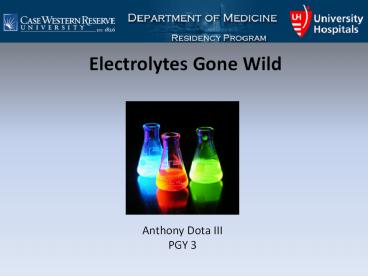Electrolytes Gone Wild - PowerPoint PPT Presentation
1 / 29
Title:
Electrolytes Gone Wild
Description:
... for nearly a week and has been taking only sips of water to ease his throat pain. ... our patient had a 10 meq/L gap to reach a normal sodium concentration ... – PowerPoint PPT presentation
Number of Views:36
Avg rating:3.0/5.0
Title: Electrolytes Gone Wild
1
Electrolytes Gone Wild
Anthony Dota III PGY 3
2
Outline
- Hyponatremia
- Hypernatremia
- Hypokalemia
- Hyperkalemia
3
Hyponatremia
- Most common electrolyte disturbance in
hospitalized patients - Sodium less than 135 meq/liter
- Can be asymptomatic or manifest as confusion,
seizures, coma, depends mostly on rate of change - Treatment based on specific etiology
4
Hyponatremia
- First Step
- Determine Plasma
Osmolality - Hypotonic Isotonic
Hypertonic - Normal Plasma Osmolality 275 290 mosmol/kg
5
Hypertonic Hyponatremia
- Hypertonic Hyponatremia- osmolality gt 290
- Excess of an alternate effective osmole, causes
include - administration of maltose containing solutions
common in IVIG infusion - hypertonic mannitol infusion as used to treat
increased ICP - hyperglycemia
6
Hypertonic Hyponatremia
119
105
20
850
4.2
15
1.0
- Hypertonic hyponatremia
- 2.4 meq/L increase in sodium for every 100 mg/dL
above normal for glucose (7.5 x 2.4 18) - Often times, with correction the sodium will be
within the normal reference range, so here treat
the hyperglycemia
7
Isotonic Hyponatremia
- Pseudohyponatremia
- hyperlipidemia/hyperproteinemia
- Addition of a non-sodium containing isoosmotic
solution - intravesicular exposure to glycine/sorbitol
common during CBI for urologic procedures
8
Hypotonic Hyponatremia
- Plasma osmolality lt 275, most common
- First Step
- Determine Volume
Status - Hypovolemic Euvolemic
Hypervolemic
9
Hypotonic Hyponatremia
- Hypovolemic
- Renal losses (diuretics, adrenal insufficiency)
- Extra-renal (diarrhea, inadequate po, insensible
loss)
10
Hypotonic Hyponatremia
- Euvolemic
- SIADH (most commonly)
- Adrenal insufficiency
- Hypothyroidism
- Psychogenic polydipsia
- Low solute intake (beer, or tea toast)
11
Hypotonic Hyponatremia
- Hypervolemic
- Congestive heart failure
- Liver cirrhosis
- Nephrotic syndrome
- Advanced renal failure
12
Hypotonic Hyponatremia
- Treatment
- Hypervolemic- fluid restriction, /- diuresis
- Euvolemic- free water restriction
- if due to SIADH, and patient is euvolemic, will
worsen with normal saline, if due to SIADH use
ADH antagonists, free water restriction, and
treat underlying cause (i.e. cessation of
iatrogenic etiology such as SSRIs) - Hypovolemic- treat with normal saline
13
- Hypertonic should only be administered in the
ICU setting with the aid of a fellow, and for CNS
symptomatology - In CNS affected patients you may correct the
sodium at a more rapid rate of 1.5 2.0 meq/L/hr
until symptoms resolve - In non-CNS affected patients, correct at no more
than 0.5 meq/L/hr with frequent metabolic panels
14
So in a situation when saline is indicated, what
concentration do I use and how fast should I
administer it?????
15
- CASE
- 75 year old gentleman with a history of
esophageal carcinoma receiving radiation therapy
presents to the emergency department with
dysphagia for 1 month, and more recently
diarrhea. He has been unable to tolerate solid
food for nearly a week and has been taking only
sips of water to ease his throat pain. Initial
laboratories demonstrate a sodium of 115 meq/L,
and he does complain of some generalized malaise,
and some muscle cramps.
16
- Physical Examination
- T-97, RR-12, HR-115, BP-105/75, SaO2-97 on room
air - Orthostatics
- Dry mucous membranes
- Decreased skin turgor
17
- Send serum osmolality, guaranteed to be low
- Hypotonic, hypovolemic, hyponatremia
- Normal saline (Keep time frame in mind )
- 135 meq - 115 meq 20
meq
1 L
1 L
1 L
40 hours
20 meq Volume of container Liters (TBW)
840 meq
1 L
18
- 840 meq / Na 1 Liter / NS
5.5 Liters / NS
154 meq / Na
- 5,500 ml / NS 136 ml / NS
40 hours
hour
19
Hypernatremia
- Most often from a free water deficit secondary
to secretory and osmotic diarrheas, osmotic
diuresis, no access to free water, central thirst
mechanism problems - Diabetes insipidus, unique, lack of ADH or no
response - CASE Patient with sodium of 155 meq/L
155 meq TBW (70 0.6) 6510
meq/Na
1 L
20
6510 meq/Na 145 meq/Na
44.89 liters
X Liters
1 Liter
44.89 Liters - 42 Liters 2890 ml
(free water deficit)
42 Liters
44.89 Liters
21
- Now we know the free water deficit, how fast to
correct it??? - Same as hyponatremia, no more than 0.5
meq/Liter/hour, or cerebral edema may ensue - So using this formula, our patient had a 10
meq/L gap to reach a normal sodium concentration
10 meq 1 L hr 20 hours
1 L
0.5 meq
2,890 ml 145 ml/hour (of free
water)
20 hours
22
Hypernatremia
- To be exact regarding this calculation as in ICU
settings, must adjust for daily insensible free
water loss - Typically 30 40 ml of free water per day, add
these to your fluids - With urine output in ICU, estimate osmolality by
Na K
23
Hypernatremia
- Diabetes Insipidus
- Central need to give ADH (vasopressin)
- Nephrogenic partial or complete
- unlimited access to free water
- low salt diet
- paradoxically thiazide diuretics
24
Hypokalemia
- Normal range 3.5 5.0 meq/L
- Caused by diuresis, Conns syndrome, alkalosis,
high insulin doses, diarrhea, type I RTA - Decreased reflexes, rhabdo
- ECG findings
- Repletion, check Mag
25
Hyperkalemia
- Causes acidosis, ace-inhibitors, sparing
diuretics, potassium supplementation, renal
failure, hypoaldosteronism, tumor lysis - Case
- Nurse on LK 65 calls you regarding a patient you
are cross-covering on from the sister team. The
evening renal function panel that was drawn
showed K is 6.5 . What would you like to do?????
26
(No Transcript)
27
Hyperkalemia
- Treatment
- Calcium
- Insulin
- D50
- Kayexelate
28
Hyperkalemia
- other ECG changes
- K gt 7
- Acute renal failure, crush injuries, altered
mentation
29
END































